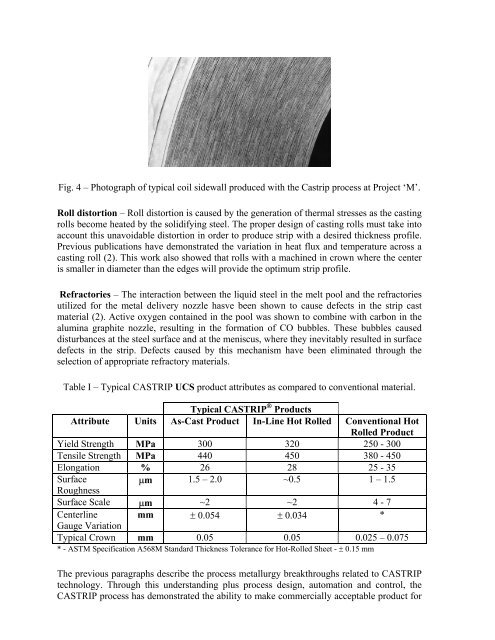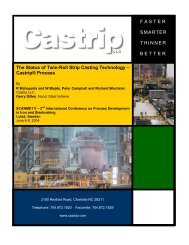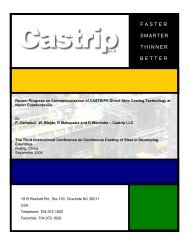The Castrip® Process for the Twin-Roll Casting
The Castrip® Process for the Twin-Roll Casting
The Castrip® Process for the Twin-Roll Casting
Create successful ePaper yourself
Turn your PDF publications into a flip-book with our unique Google optimized e-Paper software.
Fig. 4 – Photograph of typical coil sidewall produced with <strong>the</strong> Castrip process at Project ‘M’.<br />
<strong>Roll</strong> distortion – <strong>Roll</strong> distortion is caused by <strong>the</strong> generation of <strong>the</strong>rmal stresses as <strong>the</strong> casting<br />
rolls become heated by <strong>the</strong> solidifying steel. <strong>The</strong> proper design of casting rolls must take into<br />
account this unavoidable distortion in order to produce strip with a desired thickness profile.<br />
Previous publications have demonstrated <strong>the</strong> variation in heat flux and temperature across a<br />
casting roll (2). This work also showed that rolls with a machined in crown where <strong>the</strong> center<br />
is smaller in diameter than <strong>the</strong> edges will provide <strong>the</strong> optimum strip profile.<br />
Refractories – <strong>The</strong> interaction between <strong>the</strong> liquid steel in <strong>the</strong> melt pool and <strong>the</strong> refractories<br />
utilized <strong>for</strong> <strong>the</strong> metal delivery nozzle hasve been shown to cause defects in <strong>the</strong> strip cast<br />
material (2). Active oxygen contained in <strong>the</strong> pool was shown to combine with carbon in <strong>the</strong><br />
alumina graphite nozzle, resulting in <strong>the</strong> <strong>for</strong>mation of CO bubbles. <strong>The</strong>se bubbles caused<br />
disturbances at <strong>the</strong> steel surface and at <strong>the</strong> meniscus, where <strong>the</strong>y inevitably resulted in surface<br />
defects in <strong>the</strong> strip. Defects caused by this mechanism have been eliminated through <strong>the</strong><br />
selection of appropriate refractory materials.<br />
Table I – Typical CASTRIP UCS product attributes as compared to conventional material.<br />
Typical CASTRIP ® Products<br />
Attribute Units As-Cast Product In-Line Hot <strong>Roll</strong>ed Conventional Hot<br />
<strong>Roll</strong>ed Product<br />
Yield Strength MPa 300 320 250 - 300<br />
Tensile Strength MPa 440 450 380 - 450<br />
Elongation % 26 28 25 - 35<br />
Surface<br />
Roughness<br />
µm 1.5 – 2.0 ~0.5 1 – 1.5<br />
Surface Scale µm ~2 ~2 4 - 7<br />
Centerline mm ± 0.054 ± 0.034 *<br />
Gauge Variation<br />
Typical Crown mm 0.05 0.05 0.025 – 0.075<br />
* - ASTM Specification A568M Standard Thickness Tolerance <strong>for</strong> Hot-<strong>Roll</strong>ed Sheet - ± 0.15 mm<br />
<strong>The</strong> previous paragraphs describe <strong>the</strong> process metallurgy breakthroughs related to CASTRIP<br />
technology. Through this understanding plus process design, automation and control, <strong>the</strong><br />
CASTRIP process has demonstrated <strong>the</strong> ability to make commercially acceptable product <strong>for</strong>





